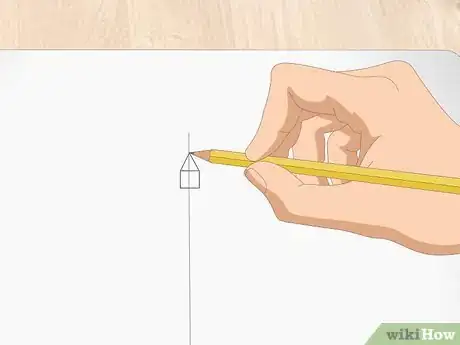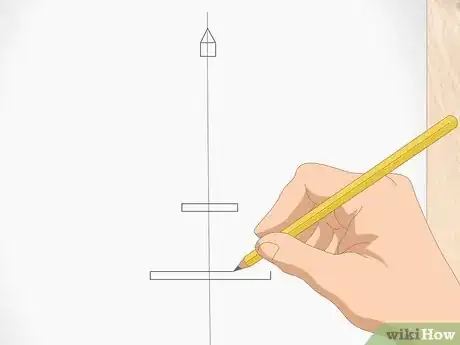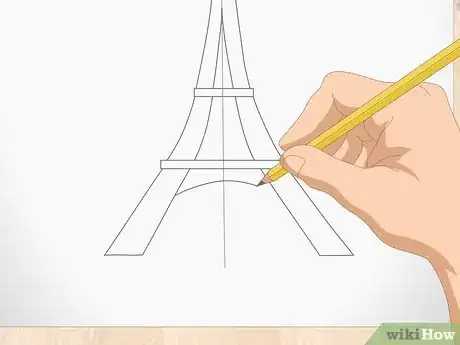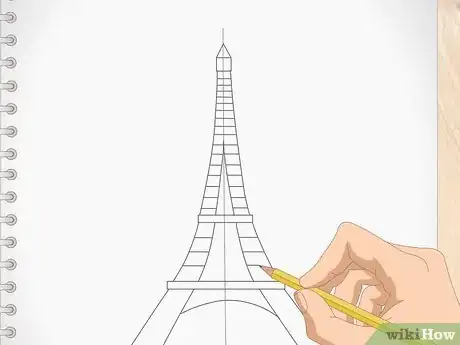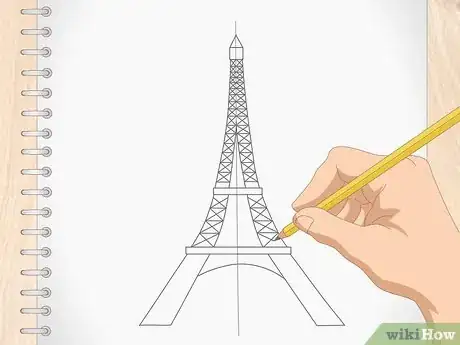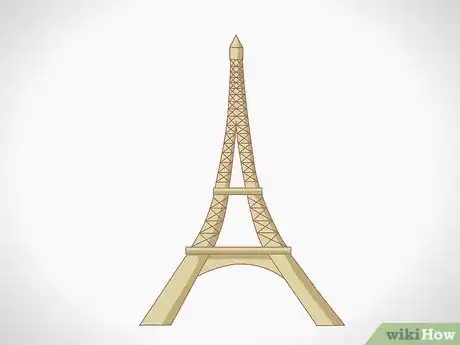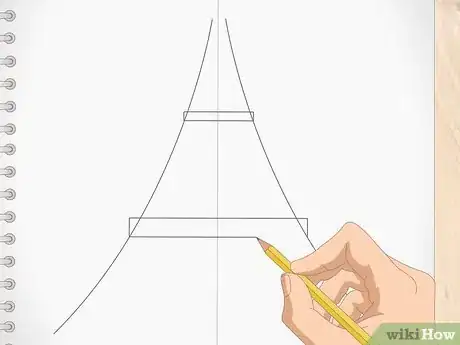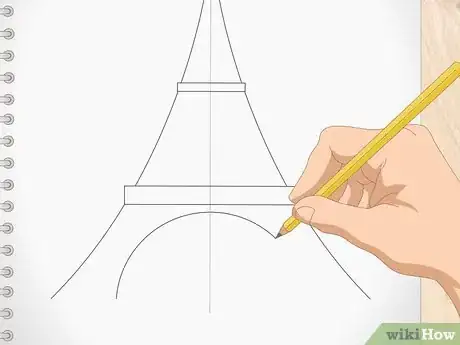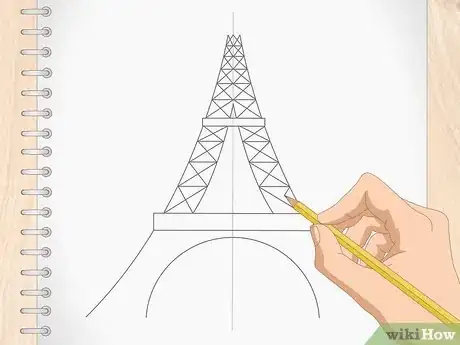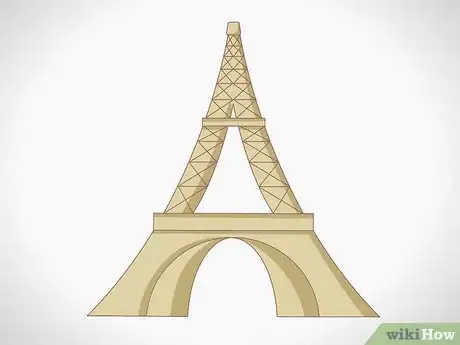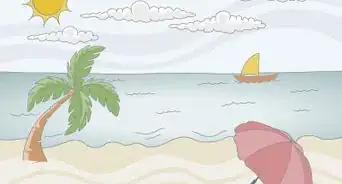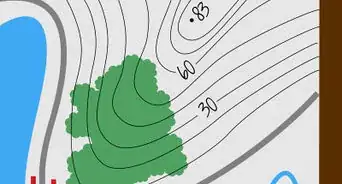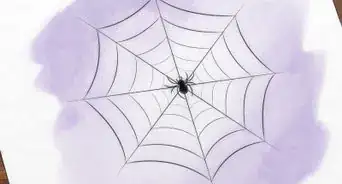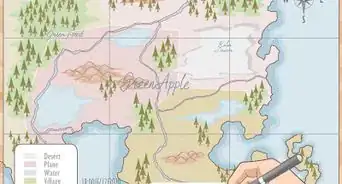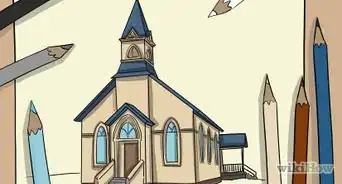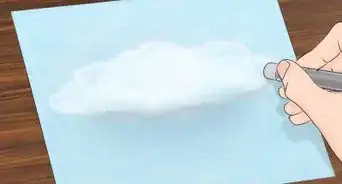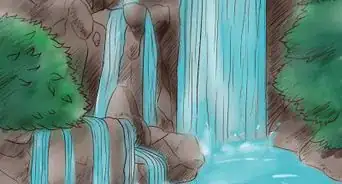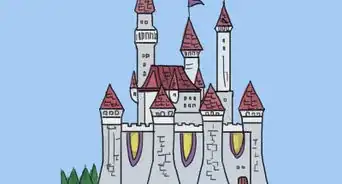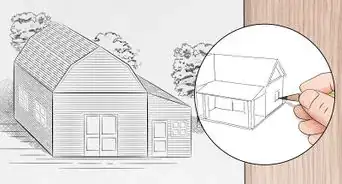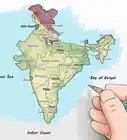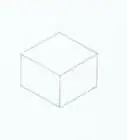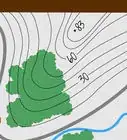This article was co-authored by wikiHow staff writer, Hunter Rising. Hunter Rising is a wikiHow Staff Writer based in Los Angeles. He has more than three years of experience writing for and working with wikiHow. Hunter holds a BFA in Entertainment Design from the University of Wisconsin - Stout and a Minor in English Writing.
There are 15 references cited in this article, which can be found at the bottom of the page.
This article has been viewed 815,345 times.
Learn more...
The Eiffel Tower is one of the most recognizable landmarks in Paris, France. While it may seem like a complex piece of architecture to draw, you can easily sketch it out with a bit of practice. Drawing the Eiffel Tower from a straight-on view will be the easiest, but you can also make it look more impressive by drawing it in 3D perspective. After a little patience and practice, you’ll be able to draw it on your own!
Steps
Drawing a Simple Eiffel Tower
-
1Draw a straight guide line down the middle of your paper. Lay your paper vertically so you can fit the entire tower on your sheet. Use a pencil and ruler to make a straight vertical line in the center of the page to use as your guide. Since the Eiffel Tower is symmetrical, it will look the same on both sides of the line. Make sure there’s a small gap between the top and bottom of the page and the center line so you have room to draw the tip and legs of the tower.[1]
- Work lightly so you can easily erase your marks if you make a mistake.
- You can work with your paper horizontally, but you won’t be able to draw your tower as tall as you would if it was vertical.
-
2Put a square with a triangle on it on top of the line. The top of the Eiffel Tower has a viewing platform and antenna that are shaped like a square and triangle when you look at them from the front. Draw in a small square that’s about the size of your thumb nail at the top so the line goes through the middle of it. Once you have the square drawn, put a triangle with a steep point on top of it for the antenna.[2]
- Don’t draw the square and triangle too big or else you won’t be able to draw the rest of the tower proportionally correct.
Advertisement -
3Sketch in 2 horizontal rectangles perpendicular to the line for the viewing platforms. Find the halfway point of the center guide and make a narrow horizontal rectangle that’s about twice the width of the square. Then find the halfway point between that rectangle and the bottom of the line so you know where to place the second rectangle. Make the second rectangle about twice the length of the first one.[3]
-
4Make curved lines from the corners of the square to the corners of the bottom rectangle. Place your pencil on one of the bottom corners of the square on top. Draw a curved line down so it goes through the top corner of the upper rectangle and ends at the top corner of the lower rectangle. Repeat the process from the other bottom corner of the square on the opposite side of your tower.[4]
- Don’t extend the curved lines all the way to the bottom of the page since the legs on the bottom of the Eiffel Tower are straighter.
-
5Draw curved lines that are parallel to the first ones you drew so they come from the center. Start your lines about a third of the way down the center guide for your tower. Draw a line on one side of the guide so it follows the same curve as the line you just drew. End the curved line so it’s about a third of the way in from the end of the bottom rectangle. Draw another curved line on the opposite side of the guide following the curve on that side.[5]
- It’s okay if your curves aren’t perfectly parallel with one another since the Eiffel Tower starts to get wider near the bottom.
-
6Put in 45-degree angled lines coming down from the bottom rectangle. Start your first line in one of the bottom corners of the lower rectangle, and extend it down away from the center guide. Once the end lines up with the bottom of the center guide, stop drawing the angle. Start the next angled line a third of the way from the end of the rectangle. When the ends of the angles line up, connect them with a straight horizontal line. Repeat the process on the other side of the tower.[6]
- Remember the Eiffel Tower is symmetrical so the left and right side should look the same once you’re finished.
-
7Add an upside-down curve between the tower’s legs to connect them. The Eiffel Tower has curved supports between the legs to keep it sturdy. Start the curved line about a third of the way down the leg and make it arch up toward the center of the bottom rectangle. Make the curve symmetrical across the center guide to connect the legs.[7]
- Don’t let the top of the curve touch the bottom of the rectangle.
-
8Sketch horizontal lines between the parallel curves to make the girders. Start from the tip of the tower and work your way down toward the legs to split them into equally sized rectangles. As you get closer to the bottom, allow a little more space between the horizontal lines to make them further apart. When you’re finished, the legs should have 3-4 rectangles, the area between the viewing platforms will have 3-4 rectangles, and the area between the top viewing platform and tip will have 15-16 small rectangles.[8]
Tip: Make sure the horizontal lines are in the same spot on each side of the tower or else it won’t look symmetrical.
-
9Draw an X in each rectangle of the girders. Put an X between each of the lines you just drew to add the cross supports to the tower’s girders. Make sure the center of the X is in the middle of each rectangle so the tower looks correct. Once you fill in the rest of the triangles, your Eiffel Tower is finished![9]
- You can also add small X-shapes along the viewing platforms and on the bottom arch if you want to add more detail to your drawing.
-
10Finished.
Sketching the Eiffel Tower in Perspective
-
1Draw a straight line down the middle of your paper. You can either position your paper vertically or horizontally when you start drawing the Eiffel Tower. Work lightly in pencil to add a line down the center of your paper to use as a guide. Be sure to leave a small gap at the top and the bottom of the sheet so you have room to add some details later.[10]
-
2Sketch in sweeping curved lines on either side of the center line. Start one of your curved lines on the right side of the guide you drew earlier. Leave a small gap between the guide and the curved line at the end. As you draw the line toward the bottom of your paper, make the curve get further away from the line. Make another curved line that’s symmetrical to the first one on the other side of the guide. Your drawing will look similar to a triangle with curved sides.[11]
- The perspective of the drawing resembles standing near the base of the Eiffel Tower and looking up at it.
-
3Make horizontal rectangles to split the center line into thirds. Measure a third of the way down the length of the guide line and make a narrow horizontal rectangle that extends slightly past the curved lines on each side. Then measure another third down the center guide so you know where to place the next rectangle. Make the second rectangle about twice as thick and long as the first one so it looks like it’s closer to you.[12]
- The rectangles are the bottoms of the Eiffel Tower’s viewing platforms.
-
4Put 2 upside-down curves below the bottom rectangle to make the legs. The curves on the bottom will be the arch that spans between the tower’s legs. Start from the center guide just below the bottom rectangle and curve it out until it’s parallel with the first sweeping curve you made on the side. Repeat the process on the other side of the tower so the arch is symmetrical. Make another curved line just underneath the first one so it looks like an archway.[13]
-
5Draw a triangle with curved sides so its point extends up past the top rectangle. Start the base of the triangle on top of the lowest rectangle about a third of the way in from each end. Make a curved line up from the lower rectangle that’s parallel with the outer curve of the tower so it goes through the top rectangle. End the line halfway between the top rectangle and the end of the guide line. Draw the other side of the triangle coming up from the other side to form a point on top.[14]
- It’s okay to draw the lines through the rectangles at first. Just be sure to erase them so they aren’t in your final drawing.
-
6Add straight horizontal lines between the curves to form the girders. Once you have the base of the structure drawn, start adding the support girders on it. Begin at the tip of the tower and draw straight horizontal lines from one of the outer curved lines to the other to make small rectangles. Make the lines closer together near the top and further apart near the bottom to show that they’re closer to you.[15]
- When you’re finished, there will be 15-16 lines from the tip to the top viewing platform, 3-4 lines between the viewing platforms, and 3-4 lines on each leg.
-
7Make Xs in each of the spaces along the girders. Add an X-shape between each of the horizontal lines you just drew to make the cross supports. Make sure the ends of the X extend into the corners of the space so it looks like they’re connected to the tower.[16]
Tip: Draw the lines of the X lightly as you’re close to the tip and darker as you get closer to the bottom. That will help give the illusion that the tip is further away than the base.
-
8Sketch lines inside of the archway to add the supports. The direction you draw your lines depends on where it is along the arch since you’re drawing in perspective. Start by drawing a straight vertical line between the 2 curves of the arch so it’s along the center guide. As you add lines along the arch, angle them in toward the center. The lines near the bottom of the arch will be nearly horizontal. When you’re finished, you should have about 6 evenly spaced lines on each side of the guide.[17]
- If you want to add more depth to your drawing, make small rectangles instead of single lines. That way, the supports will look three-dimensional.
-
9Put a rounded square on top of the tower to add the point. At the top of your tower, make a square with rounded corners so it extends slightly out from the tip. Don’t overlap any lines with parts of the tower you already drew or else the drawing will look messy. Once you have the point on top of the tower, your drawing’s finished![18]
-
10Finished.
Community Q&A
-
QuestionWhy did Gustave Eiffel build it the tower?
 Community AnswerThe Eiffel tower was built for a World Fair in 1889 and was supposed to be removed after, but it wasn't and eventually grew as a landmark for Parisians. So basically, Gustave built it for the 1889 World's fair.
Community AnswerThe Eiffel tower was built for a World Fair in 1889 and was supposed to be removed after, but it wasn't and eventually grew as a landmark for Parisians. So basically, Gustave built it for the 1889 World's fair. -
QuestionHow long did it take to build the Eiffel Tower?
 Community AnswerIt took a total of two years, two months, and five days. The work was started in 1887, and the tower was inaugurated in 1889.
Community AnswerIt took a total of two years, two months, and five days. The work was started in 1887, and the tower was inaugurated in 1889. -
QuestionWho built the Eiffel Tower?
 Community AnswerGustave Eiffel built the Eiffel Tower. (Source: Wikipedia)
Community AnswerGustave Eiffel built the Eiffel Tower. (Source: Wikipedia)
Things You’ll Need
- Paper
- Ruler
- Pencil
- Eraser
References
- ↑ https://easydrawingguides.com/draw-eiffel-tower/
- ↑ https://easydrawingguides.com/draw-eiffel-tower/
- ↑ https://easydrawingguides.com/draw-eiffel-tower/
- ↑ https://youtu.be/fUdUNHkJeuw?t=19
- ↑ https://youtu.be/fUdUNHkJeuw?t=83
- ↑ https://easydrawingguides.com/draw-eiffel-tower/
- ↑ https://youtu.be/fUdUNHkJeuw?t=112
- ↑ https://youtu.be/Vs_WTigyT24?t=114
- ↑ https://youtu.be/Vs_WTigyT24?t=137
- ↑ https://youtu.be/tqkZGBsSYw4?t=22
- ↑ https://youtu.be/tqkZGBsSYw4?t=21
- ↑ https://youtu.be/tqkZGBsSYw4?t=81
- ↑ https://youtu.be/tqkZGBsSYw4?t=48
- ↑ https://youtu.be/tqkZGBsSYw4?t=116
- ↑ https://youtu.be/tqkZGBsSYw4?t=221
- ↑ https://youtu.be/tqkZGBsSYw4?t=237
- ↑ https://youtu.be/tqkZGBsSYw4?t=151
- ↑ https://youtu.be/tqkZGBsSYw4?t=574
About This Article
To draw the Eiffel Tower from the front, start constructing the basic shape by drawing a curved triangle, and then another smaller one inside of it. Then, capture the levels of the tower by drawing two horizontal lines just below the inner tip, and two more horizontal lines about halfway down the structure. To form the arch at the base of the tower, draw half an oval to connect the two sides. Finally, add details like X’s between the columns to replicate the steel structure. To learn how to draw the Eiffel Tower from below, keep scrolling!

